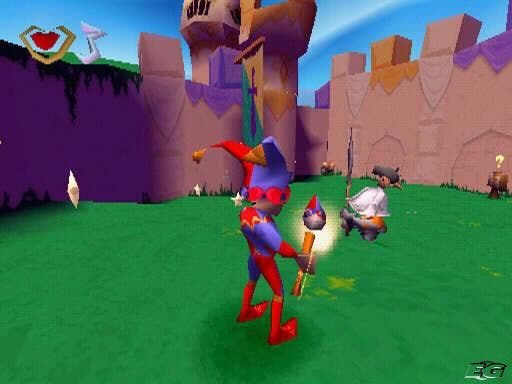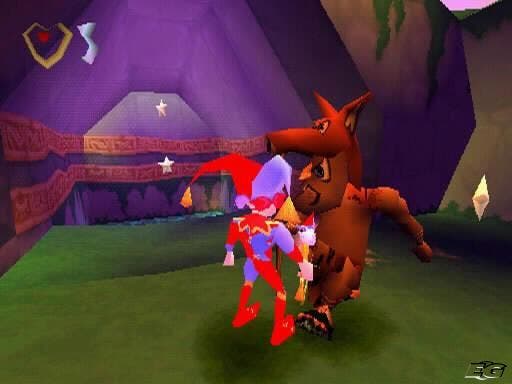Jinx
Review - a dismissive missive of the jingly one
Let's get one thing straight from the start; Jesters do not make good video game characters. They make bell noises when they run, and have a fixed grin that merely inspires irrational hatred. Hands up who wants to be a Jester? Hmmmm. The Rent-a-ghost loon was mildly amusing 20 odd years ago, and Pandemonium was ok, ish, but we can't see anyone rushing to do a next gen sequel.
Also pushing the Jester concept hard in the list of "things that should be outlawed in game development" is making self consciously 'kiddie' games. It's just a bad idea. It never works. Stop it. But Sony, as the platform holder, still has to be seen to support the ageing PSone thanks to its steadfast refusal to stop selling, and figures that bunging out an inoffensive colourful 3D platform game for £20 is the way to keep mum and her little Johnny quiet.

They took a Hammer to it
There, with that out of the way, we can feel the tension draining out of our bodies and can go about our task of describing what Jinx is all about for the few of you who care. The first thing you need to know is that Hammerhead did the development - having done a sterling job of porting Quake II to PSone back in '99 and coding Blade (with slightly less impressive results) for Activision. Thus, on a technical level, at least, we were ready to give Jester a chance to impress us.
The man with the jingly hat, Jinx, is the star of the game; a failed magician, the son of a powerful wizard who now works as a court jester for King Mamooset XIV. Waking up to find the world in chaos, Jinx finds a group of pirates led by Captain Gripply has attacked the land of Ploog, turning friend against friend with a powerful spell, and to add insult to injury the pirates have kidnapped the royal family and scattered members of the court across the game world. In other words, he must bound around a colourful world with lots of stars to collect, doors to unlock, traps to traverse, blocks to push, water to swim in, and baddies to bop.
Unlike the staple platform fare of the 128-bit era, Jinx sticks to one style of game - the run, jump and collect of old, and thus the game pretty much plays its entire hand in the first half an hour. It's colourful, it's generic, it's harmless, and utterly devoid of any spark of imagination or originality whatsoever, but hey, what did we really expect?

Challenging? Yeah, right.
Every level we encountered has you searching around for objects for the characters you meet so that platforms descend or doors unlock - ensuring your progress. It starts off with very simple "find key" or "find cog" type tasks, then rapidly builds up to having to find multiple objects: find seven roses, round up eight cows, that kind of thing. But whatever it is you're tasked with, it's the kind of utterly predictable platform game that most of us thought had been left behind a long time ago. Beating each clueless baddie consists of pressing the square button when you're in the vicinity. If they don't go down first time, then a second or third crack normally does the trick. And if you don't know what to do, there are dozens of sign posts to tell you exactly how to progress. Oh yes. Challenging Jinx is not.
If the utter vaccuousness of the gameplay wasn't enough to have any sane minded gamer reaching for the off switch, there's always the hideous camera system to kill any last remaining dregs of enthusiasm. Time after time you're forced to make leaps of faith because the camera point blank refuses to give you a decent view of the action - and with a fairly clunky control system you'll be continually plunging to instant death. L1 and R1 are assigned to give you manual control, but it's next to useless thanks to the game wrenching control back when it feels like it. R2 gives the player a free look option, which just about save you from throwing the joypad at the TV, but only just.
Despair
What will have every gamer, young or old, despairing is the save system - unlike every modern platformer, Jinx offers very few save opportunities, and regularly you'll be asked to start entire worlds from scratch if you've not had the chance to save before your lives run out. Once this kind of event happens, your will to return to the game is totally gone.
Visually it's not bad for a PSone game, but by no means some kind of revelation either. Yes, the worlds are big and bright, the textures functional, and the character models quite detailed and rounded. But in this 128-bit era, playing a game on nine year old technology is always going to take a fair bit of forgiveness - so seeing walls break up, and chunky textures, you're destined to wince now and then.
Plink, Plonk, Rinky Dink
The audio deserves a special mention for having the ability to drive you up the wall in record time. It's real plinky plonky nonsense of the highest order, and any parent reading this should avoid the game on this basis alone - or at least have the mute button poised if your offspring is playing the game in the same room.
Overall, you'll play worse games than Jinx - it does what it sets out to do; i.e. be a safe, neat, no frills platformer, that is suitable for children. But then there are dozens of better games in the genre on the PSone, and most of them will be available at a fraction of the price. Avoid.
Jinx screenshots (PSX)

